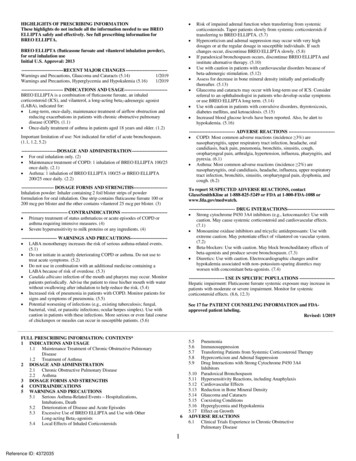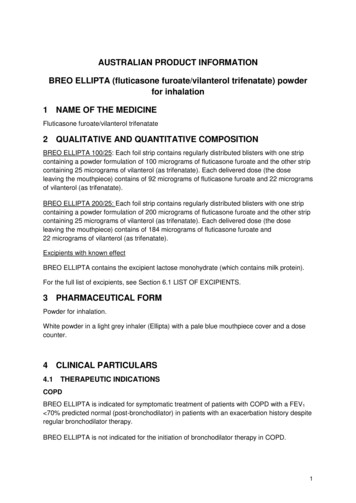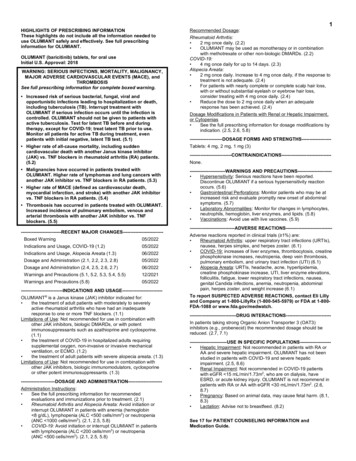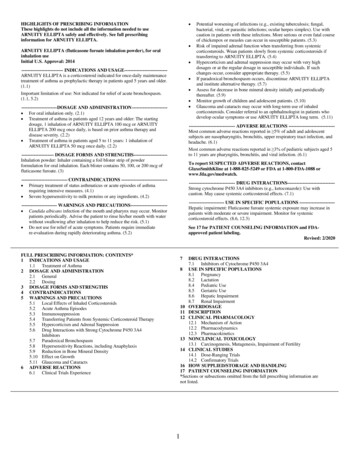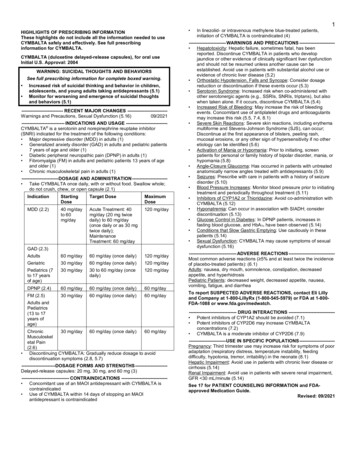
Transcription
HIGHLIGHTS OF PRESCRIBING INFORMATIONThese highlights do not include all the information needed to use BREO ELLIPTA safely and effectively. See full prescribing information forBREO ELLIPTA. BREO ELLIPTA 100/25 (fluticasone furoate 100 mcg and vilanterol25 mcg inhalation powder), for oral inhalationBREO ELLIPTA 200/25 (fluticasone furoate 200 mcg and vilanterol25 mcg inhalation powder), for oral inhalationInitial U.S. Approval: 2013 WARNING: ASTHMA-RELATED DEATHSee full prescribing information for complete boxed warning.Long-acting beta2-adrenergic agonists (LABA), such as vilanterol,increase the risk of asthma-related death. A placebo-controlled trialwith another LABA (salmeterol) showed an increase inasthma-related deaths. This finding with salmeterol is considered aclass effect of all LABA. Currently available data are inadequate todetermine whether concurrent use of inhaled corticosteroids (ICS) orother long-term asthma control drugs mitigates the increased risk ofasthma-related death from LABA. Available data from controlledclinical trials suggest that LABA increase the risk of asthma-relatedhospitalization in pediatric and adolescent patients. (5.1)When treating patients with asthma, only prescribe BREO ELLIPTAfor patients not adequately controlled on a long-term asthma controlmedication, such as an ICS, or whose disease severity clearlywarrants initiation of treatment with both an ICS and a LABA. Onceasthma control is achieved and maintained, assess the patient atregular intervals and step down therapy (e.g., discontinue BREOELLIPTA) if possible without loss of asthma control and maintainthe patient on a long-term asthma control medication, such as an ICS.Do not use BREO ELLIPTA for patients whose asthma is adequatelycontrolled on low- or medium-dose ICS. (1.2, 5.1) ------------------------------ ADVERSE REACTIONS ----------------------------- COPD: Most common adverse reactions (incidence greater than or equalto 3%) are nasopharyngitis, upper respiratory tract infection, headache,and oral candidiasis. (6.1) Asthma: Most common adverse reactions (incidence greater than or equalto 2%) are nasopharyngitis, oral candidiasis, headache, influenza, upperrespiratory tract infection, bronchitis, sinusitis, oropharyngeal pain,dysphonia, and cough. (6.2)--------------------------- INDICATIONS AND USAGE--------------------------- BREO ELLIPTA is a combination of fluticasone furoate, an inhaledcorticosteroid (ICS), and vilanterol, a long-acting beta2-adrenergic agonist(LABA), indicated for: Long-term, once-daily, maintenance treatment of airflow obstruction andreducing exacerbations in patients with chronic obstructive pulmonarydisease (COPD). (1.1) Once-daily treatment of asthma in patients aged 18 years and older. (1.2)To report SUSPECTED ADVERSE REACTIONS, contactGlaxoSmithKline at 1-888-825-5249 or FDA at 1-800-FDA-1088 orwww.fda.gov/medwatch.Important limitation: Not indicated for relief of acute bronchospasm. (1.1, 1.2,5.2)------------------------------ DRUG INTERACTIONS------------------------------ Strong cytochrome P450 3A4 inhibitors (e.g., ketoconazole): Use withcaution. May cause systemic corticosteroid and cardiovascular effects.(7.1) Monoamine oxidase inhibitors and tricyclic antidepressants: Use withextreme caution. May potentiate effect of vilanterol on vascular system.(7.2) Beta-blockers: Use with caution. May block bronchodilatory effects ofbeta-agonists and produce severe bronchospasm. (7.3) Diuretics: Use with caution. Electrocardiographic changes and/orhypokalemia associated with non–potassium-sparing diuretics mayworsen with concomitant beta-agonists. (7.4)-----------------------DOSAGE AND ADMINISTRATION ---------------------- For oral inhalation only. (2) Maintenance treatment of COPD: 1 inhalation of BREO ELLIPTA 100/25once daily. (2.1) Asthma: 1 inhalation of BREO ELLIPTA 100/25 or BREO ELLIPTA200/25 once daily. (2.2)--------------------- DOSAGE FORMS AND STRENGTHS--------------------- Inhalation Powder. Inhaler containing 2 foil blister strips of powderformulation for oral inhalation. One strip contains fluticasone furoate 100 or200 mcg per blister and the other contains vilanterol 25 mcg per blister. (3)----------------------- USE IN SPECIFIC POPULATIONS ---------------------- Hepatic impairment: Fluticasone furoate exposure may increase in patientswith moderate or severe impairment. Monitor for systemic corticosteroideffects. (8.6, 12.3)------------------------------ CONTRAINDICATIONS ----------------------------- Primary treatment of status asthmaticus or acute episodes of COPD orasthma requiring intensive measures. (4) Severe hypersensitivity to milk proteins or any ingredients. (4)See 17 for PATIENT COUNSELING INFORMATION and MedicationGuide.Revised: 10/2016----------------------- WARNINGS AND PRECAUTIONS----------------------- LABA increase the risk of asthma-related death and asthma-relatedhospitalizations. Prescribe only for recommended patient populations.(5.1)FULL PRESCRIBING INFORMATION: CONTENTS*WARNING: ASTHMA-RELATED DEATH1 INDICATIONS AND USAGE1.1 Maintenance Treatment of Chronic Obstructive PulmonaryDisease1.2 Treatment of Asthma231Reference ID: 4006672Do not initiate in acutely deteriorating COPD or asthma. Do not use totreat acute symptoms. (5.2)Do not use in combination with an additional medicine containing aLABA because of risk of overdose. (5.3)Candida albicans infection of the mouth and pharynx may occur. Monitorpatients periodically. Advise the patient to rinse his/her mouth with waterwithout swallowing after inhalation to help reduce the risk. (5.4)Increased risk of pneumonia in patients with COPD. Monitor patients forsigns and symptoms of pneumonia. (5.5)Potential worsening of infections (e.g., existing tuberculosis; fungal,bacterial, viral, or parasitic infections; ocular herpes simplex). Use withcaution in patients with these infections. More serious or even fatal courseof chickenpox or measles can occur in susceptible patients. (5.6)Risk of impaired adrenal function when transferring from systemiccorticosteroids. Taper patients slowly from systemic corticosteroids iftransferring to BREO ELLIPTA. (5.7)Hypercorticism and adrenal suppression may occur with very highdosages or at the regular dosage in susceptible individuals. If suchchanges occur, discontinue BREO ELLIPTA slowly. (5.8)If paradoxical bronchospasm occurs, discontinue BREO ELLIPTA andinstitute alternative therapy. (5.10)Use with caution in patients with cardiovascular disorders because ofbeta-adrenergic stimulation. (5.12)Assess for decrease in bone mineral density initially and periodicallythereafter. (5.13)Close monitoring for glaucoma and cataracts is warranted. (5.14)Use with caution in patients with convulsive disorders, thyrotoxicosis,diabetes mellitus, and ketoacidosis. (5.15)Be alert to hypokalemia and hyperglycemia. (5.16)DOSAGE AND ADMINISTRATION2.1 Chronic Obstructive Pulmonary Disease2.2 AsthmaDOSAGE FORMS AND STRENGTHS
45677.2Monoamine Oxidase Inhibitors and TricyclicAntidepressants7.3 Beta-adrenergic Receptor Blocking Agents7.4 Non–Potassium-Sparing Diuretics8 USE IN SPECIFIC POPULATIONS8.1 Pregnancy8.2 Labor and Delivery8.3 Nursing Mothers8.4 Pediatric Use8.5 Geriatric Use8.6 Hepatic Impairment8.7 Renal Impairment10 OVERDOSAGE10.1 Fluticasone Furoate10.2 Vilanterol11 DESCRIPTION12 CLINICAL PHARMACOLOGY12.1 Mechanism of Action12.2 Pharmacodynamics12.3 Pharmacokinetics13 NONCLINICAL TOXICOLOGY13.1 Carcinogenesis, Mutagenesis, Impairment of Fertility14 CLINICAL STUDIES14.1 Chronic Obstructive Pulmonary Disease14.2 Asthma16 HOW SUPPLIED/STORAGE AND HANDLING17 PATIENT COUNSELING INFORMATION*Sections or subsections omitted from the full prescribing information are notlisted.CONTRAINDICATIONSWARNINGS AND PRECAUTIONS5.1 Asthma-Related Death5.2 Deterioration of Disease and Acute Episodes5.3 Excessive Use of BREO ELLIPTA and Use with OtherLong-acting Beta2-agonists5.4 Local Effects of Inhaled Corticosteroids5.5 Pneumonia5.6 Immunosuppression5.7 Transferring Patients from Systemic Corticosteroid Therapy5.8 Hypercorticism and Adrenal Suppression5.9 Drug Interactions with Strong Cytochrome P450 3A4Inhibitors5.10 Paradoxical Bronchospasm5.11 Hypersensitivity Reactions, Including Anaphylaxis5.12 Cardiovascular Effects5.13 Reduction in Bone Mineral Density5.14 Glaucoma and Cataracts5.15 Coexisting Conditions5.16 Hypokalemia and Hyperglycemia5.17 Effect on GrowthADVERSE REACTIONS6.1 Clinical Trials Experience in Chronic ObstructivePulmonary Disease6.2 Clinical Trials Experience in Asthma6.3 Postmarketing ExperienceDRUG INTERACTIONS7.1 Inhibitors of Cytochrome P450 3A4FULL PRESCRIBING INFORMATIONWARNING: ASTHMA-RELATED DEATHLong-acting beta2-adrenergic agonists (LABA), such as vilanterol, one of the activeingredients in BREO ELLIPTA, increase the risk of asthma-related death. Data from alarge placebo-controlled US trial that compared the safety of another LABA (salmeterol)with placebo added to usual asthma therapy showed an increase in asthma-related deathsin subjects receiving salmeterol. This finding with salmeterol is considered a class effect ofLABA. Currently available data are inadequate to determine whether concurrent use ofinhaled corticosteroids (ICS) or other long-term asthma control drugs mitigates theincreased risk of asthma-related death from LABA. Available data from controlled clinicaltrials suggest that LABA increase the risk of asthma-related hospitalization in pediatricand adolescent patients.Therefore, when treating patients with asthma, physicians should only prescribe BREOELLIPTA for patients not adequately controlled on a long-term asthma controlmedication, such as an inhaled corticosteroid, or whose disease severity clearly warrantsinitiation of treatment with both an inhaled corticosteroid and a LABA. Once asthmacontrol is achieved and maintained, assess the patient at regular intervals and step downtherapy (e.g., discontinue BREO ELLIPTA) if possible without loss of asthma control andmaintain the patient on a long-term asthma control medication, such as an inhaledcorticosteroid. Do not use BREO ELLIPTA for patients whose asthma is adequatelycontrolled on low- or medium-dose inhaled corticosteroids [see Warnings and Precautions(5.1)].2Reference ID: 4006672
1INDICATIONS AND USAGE1.1Maintenance Treatment of Chronic Obstructive Pulmonary DiseaseBREO ELLIPTA 100/25 is a combination inhaled corticosteroid/long-acting beta2-adrenergicagonist (ICS/LABA) indicated for the long-term, once-daily, maintenance treatment of airflowobstruction in patients with chronic obstructive pulmonary disease (COPD), including chronicbronchitis and/or emphysema. BREO ELLIPTA 100/25 is also indicated to reduce exacerbationsof COPD in patients with a history of exacerbations. BREO ELLIPTA 100/25 once daily is theonly strength indicated for the treatment of COPD.Important Limitation of UseBREO ELLIPTA is NOT indicated for the relief of acute bronchospasm1.2Treatment of AsthmaBREO ELLIPTA is a combination ICS/LABA indicated for the once-daily treatment of asthmain patients aged 18 years and older.LABA, such as vilanterol, one of the active ingredients in BREO ELLIPTA, increase the risk ofasthma-related death. Available data from controlled clinical trials suggest that LABA increasethe risk of asthma-related hospitalization in pediatric and adolescent patients [see Warnings andPrecautions (5.1), Adverse Reactions (6.2), Use in Specific Populations (8.4)]. Therefore, whentreating patients with asthma, physicians should only prescribe BREO ELLIPTA for patients notadequately controlled on a long-term asthma control medication, such as an inhaledcorticosteroid, or whose disease severity clearly warrants initiation of treatment with both aninhaled corticosteroid and a LABA. Once asthma control is achieved and maintained, assess thepatient at regular intervals and step down therapy (e.g., discontinue BREO ELLIPTA) if possiblewithout loss of asthma control and maintain the patient on a long-term asthma controlmedication, such as an inhaled corticosteroid. Do not use BREO ELLIPTA for patients whoseasthma is adequately controlled on low- or medium-dose inhaled corticosteroids.Important Limitation of UseBREO ELLIPTA is NOT indicated for the relief of acute bronchospasm.2DOSAGE AND ADMINISTRATIONBREO ELLIPTA should be administered once daily every day by the orally inhaled route only.BREO ELLIPTA should be taken at the same time every day. Do not use BREO ELLIPTA morethan 1 time every 24 hours.After inhalation, the patient should rinse his/her mouth with water without swallowing to helpreduce the risk of oropharyngeal candidiasis.3Reference ID: 4006672
More frequent administration or a greater number of inhalations (more than 1 inhalation daily) ofthe prescribed strength of BREO ELLIPTA is not recommended as some patients are more likelyto experience adverse effects with higher doses. Patients using BREO ELLIPTA should not useadditional LABA for any reason. [See Warnings and Precautions (5.3, 5.5, 5.8, 5.12).]2.1Chronic Obstructive Pulmonary DiseaseBREO ELLIPTA 100/25 should be administered as 1 inhalation once daily. The maximumrecommended dosage is 1 inhalation of BREO ELLIPTA 100/25 once daily, the only strengthindicated for the treatment of COPD.If shortness of breath occurs in the period between doses, an inhaled, short-acting beta2-agonist(rescue medicine, e.g., albuterol) should be taken for immediate relief.2.2AsthmaIf asthma symptoms arise in the period between doses, an inhaled, short-acting beta2-agonist(rescue medicine, e.g., albuterol) should be taken for immediate relief.The recommended starting dosage is BREO ELLIPTA 100/25 or BREO ELLIPTA 200/25administered as 1 inhalation once daily. The maximum recommended dosage is 1 inhalation ofBREO ELLIPTA 200/25 once daily.The starting dosage is based on patients’ asthma severity. For patients previously treated withlow- to mid-dose corticosteroid–containing treatment, BREO ELLIPTA 100/25 should beconsidered. For patients previously treated with mid- to high-dose corticosteroid-containingtreatment, BREO ELLIPTA 200/25 should be considered.The median time to onset, defined as a 100-mL increase from baseline in mean forced expiratoryvolume in 1 second (FEV1), was approximately 15 minutes after beginning treatment. Individualpatients will experience a variable time to onset and degree of symptom relief.For patients who do not respond adequately to BREO ELLIPTA 100/25, increasing the dose toBREO ELLIPTA 200/25 may provide additional improvement in asthma control.If a previously effective dosage regimen of BREO ELLIPTA fails to provide adequateimprovement in asthma control, the therapeutic regimen should be reevaluated and additionaltherapeutic options (e.g., replacing the current strength of BREO ELLIPTA with a higherstrength, adding additional inhaled corticosteroid, initiating oral corticosteroids) should beconsidered.3DOSAGE FORMS AND STRENGTHSInhalation powder: Disposable light grey and pale blue plastic inhaler containing 2 foil blisterstrips of powder intended for oral inhalation only. One strip contains fluticasone furoate (100 or200 mcg per blister), and the other strip contains vilanterol (25 mcg per blister).4Reference ID: 4006672
4CONTRAINDICATIONSThe use of BREO ELLIPTA is contraindicated in the following conditions: Primary treatment of status asthmaticus or other acute episodes of COPD or asthma whereintensive measures are required [see Warnings and Precautions (5.2)]. Severe hypersensitivity to milk proteins or demonstrated hypersensitivity to fluticasonefuroate, vilanterol, or any of the excipients [see Warnings and Precautions (5.11),Description (11)].5WARNINGS AND PRECAUTIONS5.1Asthma-Related DeathLABA, such as vilanterol, one of the active ingredients in BREO ELLIPTA, increase therisk of asthma-related death. Currently available data are inadequate to determinewhether concurrent use of inhaled corticosteroids or other long-term asthma control drugsmitigates the increased risk of asthma-related death from LABA. Available data fromcontrolled clinical trials suggest that LABA increase the risk of asthma-relatedhospitalization in pediatric and adolescent patients. Therefore, when treating patients withasthma, physicians should only prescribe BREO ELLIPTA for patients not adequatelycontrolled on a long-term asthma control medication, such as an inhaled corticosteroid, orwhose disease severity clearly warrants initiation of treatment with both an inhaledcorticosteroid and a LABA. Once asthma control is achieved and maintained, assess thepatient at regular intervals and step down therapy (e.g., discontinue BREO ELLIPTA) ifpossible without loss of asthma control and maintain the patient on a long-term asthmacontrol medication, such as an inhaled corticosteroid. Do not use BREO ELLIPTA forpatients whose asthma is adequately controlled on low- or medium-dose inhaledcorticosteroids.A 28-week, placebo-controlled, US trial that compared the safety of another LABA (salmeterol)with placebo, each added to usual asthma therapy, showed an increase in asthma-related deathsin subjects receiving salmeterol (13/13,176 in subjects treated with salmeterol vs. 3/13,179 insubjects treated with placebo; relative risk: 4.37 [95% CI: 1.25, 15.34]). The increased risk ofasthma-related death is considered a class effect of LABA, including vilanterol, one of the activeingredients in BREO ELLIPTA. No trial adequate to determine whether the rate ofasthma-related death is increased in subjects treated with BREO ELLIPTA has been conducted.Data are not available to determine whether the rate of death in patients with COPD is increasedby LABA.5.2Deterioration of Disease and Acute EpisodesBREO ELLIPTA should not be initiated in patients during rapidly deteriorating or potentiallylife-threatening episodes of COPD or asthma. BREO ELLIPTA has not been studied in subjects5Reference ID: 4006672
with acutely deteriorating COPD or asthma. The initiation of BREO ELLIPTA in this setting isnot appropriate.COPD may deteriorate acutely over a period of hours or chronically over several days or longer.If BREO ELLIPTA 100/25 no longer controls symptoms of bronchoconstriction; the patient’sinhaled, short-acting, beta2-agonist becomes less effective; or the patient needs more short-actingbeta2-agonist than usual, these may be markers of deterioration of disease. In this setting areevaluation of the patient and the COPD treatment regimen should be undertaken at once. ForCOPD, increasing the daily dose of BREO ELLIPTA 100/25 is not appropriate in this situation.Increasing use of inhaled, short-acting beta2-agonists is a marker of deteriorating asthma. In thissituation, the patient requires immediate reevaluation with reassessment of the treatmentregimen, giving special consideration to the possible need for replacing the current strength ofBREO ELLIPTA with a higher strength, adding additional inhaled corticosteroid, or initiatingsystemic corticosteroids. Patients should not use more than 1 inhalation once daily of BREOELLIPTA.BREO ELLIPTA should not be used for the relief of acute symptoms, i.e., as rescue therapy forthe treatment of acute episodes of bronchospasm. BREO ELLIPTA has not been studied in therelief of acute symptoms and extra doses should not be used for that purpose. Acute symptomsshould be treated with an inhaled, short-acting beta2-agonist.When beginning treatment with BREO ELLIPTA, patients who have been taking oral or inhaled,short-acting beta2-agonists on a regular basis (e.g., 4 times a day) should be instructed todiscontinue the regular use of these drugs and to use them only for symptomatic relief of acuterespiratory symptoms. When prescribing BREO ELLIPTA, the healthcare provider should alsoprescribe an inhaled, short-acting beta2-agonist and instruct the patient on how it should be used.5.3Excessive Use of BREO ELLIPTA and Use with Other Long-acting Beta2-agonistsBREO ELLIPTA should not be used more often than recommended, at higher doses thanrecommended, or in conjunction with other medicines containing LABA, as an overdose mayresult. Clinically significant cardiovascular effects and fatalities have been reported inassociation with excessive use of inhaled sympathomimetic drugs. Patients using BREOELLIPTA should not use another medicine containing a LABA (e.g., salmeterol, formoterolfumarate, arformoterol tartrate, indacaterol) for any reason.5.4Local Effects of Inhaled CorticosteroidsIn clinical trials, the development of localized infections of the mouth and pharynx with Candidaalbicans has occurred in subjects treated with BREO ELLIPTA. When such an infectiondevelops, it should be treated with appropriate local or systemic (i.e., oral) antifungal therapywhile treatment with BREO ELLIPTA continues, but at times therapy with BREO ELLIPTAmay need to be interrupted. Advise the patient to rinse his/her mouth with water withoutswallowing following inhalation to help reduce the risk of oropharyngeal candidiasis.6Reference ID: 4006672
5.5PneumoniaAn increase in the incidence of pneumonia has been observed in subjects with COPD receivingBREO ELLIPTA 100/25 in clinical trials. There was also an increased incidence of pneumoniasresulting in hospitalization. In some incidences these pneumonia events were fatal. Physiciansshould remain vigilant for the possible development of pneumonia in patients with COPD as theclinical features of such infections overlap with the symptoms of COPD exacerbations.In replicate 12-month trials in 3,255 subjects with COPD who had experienced a COPDexacerbation in the previous year, there was a higher incidence of pneumonia reported insubjects receiving fluticasone furoate/vilanterol 50 mcg/25 mcg: 6% (48 of 820 subjects); BREOELLIPTA 100/25: 6% (51 of 806 subjects); or BREO ELLIPTA 200/25: 7% (55 of 811 subjects)than in subjects receiving vilanterol 25 mcg: 3% (27 of 818 subjects). There was no fatalpneumonia in subjects receiving vilanterol or fluticasone furoate/vilanterol 50 mcg/25 mcg.There was fatal pneumonia in 1 subject receiving BREO ELLIPTA 100/25 and in 7 subjectsreceiving BREO ELLIPTA 200/25 (less than 1% for each treatment group).5.6ImmunosuppressionPersons who are using drugs that suppress the immune system are more susceptible to infectionsthan healthy individuals. Chickenpox and measles, for example, can have a more serious or evenfatal course in susceptible children or adults using corticosteroids. In such children or adults whohave not had these diseases or been properly immunized, particular care should be taken to avoidexposure. How the dose, route, and duration of corticosteroid administration affect the risk ofdeveloping a disseminated infection is not known. The contribution of the underlying diseaseand/or prior corticosteroid treatment to the risk is also not known. If a patient is exposed tochickenpox, prophylaxis with varicella zoster immune globulin (VZIG) may be indicated. If apatient is exposed to measles, prophylaxis with pooled intramuscular immunoglobulin (IG) maybe indicated. (See the respective package inserts for complete VZIG and IG prescribinginformation.) If chickenpox develops, treatment with antiviral agents may be considered.Inhaled corticosteroids should be used with caution, if at all, in patients with active or quiescenttuberculosis infections of the respiratory tract; systemic fungal, bacterial, viral, or parasiticinfections; or ocular herpes simplex.5.7Transferring Patients from Systemic Corticosteroid TherapyParticular care is needed for patients who have been transferred from systemically activecorticosteroids to inhaled corticosteroids because deaths due to adrenal insufficiency haveoccurred in patients with asthma during and after transfer from systemic corticosteroids to lesssystemically available inhaled corticosteroids. After withdrawal from systemic corticosteroids, anumber of months are required for recovery of hypothalamic-pituitary-adrenal (HPA) function.Patients who have been previously maintained on 20 mg or more of prednisone (or itsequivalent) may be most susceptible, particularly when their systemic corticosteroids have been7Reference ID: 4006672
almost completely withdrawn. During this period of HPA suppression, patients may exhibit signsand symptoms of adrenal insufficiency when exposed to trauma, surgery, or infection(particularly gastroenteritis) or other conditions associated with severe electrolyte loss. AlthoughBREO ELLIPTA may control COPD or asthma symptoms during these episodes, inrecommended doses it supplies less than normal physiological amounts of glucocorticoidsystemically and does NOT provide the mineralocorticoid activity that is necessary for copingwith these emergencies.During periods of stress, a severe COPD exacerbation, or a severe asthma attack, patients whohave been withdrawn from systemic corticosteroids should be instructed to resume oralcorticosteroids (in large doses) immediately and to contact their physicians for furtherinstruction. These patients should also be instructed to carry a warning card indicating that theymay need supplementary systemic corticosteroids during periods of stress, a severe COPDexacerbation, or a severe asthma attack.Patients requiring oral corticosteroids should be weaned slowly from systemic corticosteroid useafter transferring to BREO ELLIPTA. Prednisone reduction can be accomplished by reducingthe daily prednisone dose by 2.5 mg on a weekly basis during therapy with BREO ELLIPTA.Lung function (FEV1 or peak expiratory flow), beta-agonist use, and COPD or asthma symptomsshould be carefully monitored during withdrawal of oral corticosteroids. In addition, patientsshould be observed for signs and symptoms of adrenal insufficiency, such as fatigue, lassitude,weakness, nausea and vomiting, and hypotension.Transfer of patients from systemic corticosteroid therapy to BREO ELLIPTA may unmaskallergic conditions previously suppressed by the systemic corticosteroid therapy (e.g., rhinitis,conjunctivitis, eczema, arthritis, eosinophilic conditions).During withdrawal from oral corticosteroids, some patients may experience symptoms ofsystemically active corticosteroid withdrawal (e.g., joint and/or muscular pain, lassitude,depression) despite maintenance or even improvement of respiratory function.5.8Hypercorticism and Adrenal SuppressionInhaled fluticasone furoate is absorbed into the circulation and can be systemically active.Effects of fluticasone furoate on the HPA axis are not observed with the therapeutic doses ofBREO ELLIPTA. However, exceeding the recommended dosage or coadministration with astrong cytochrome P450 3A4 (CYP3A4) inhibitor may result in HPA dysfunction [see Warningsand Precautions (5.9), Drug Interactions (7.1)].Because of the possibility of significant systemic absorption of inhaled corticosteroids insensitive patients, patients treated with BREO ELLIPTA should be observed carefully for anyevidence of systemic corticosteroid effects. Particular care should be taken in observing patientspostoperatively or during periods of stress for evidence of inadequate adrenal response.8Reference ID: 4006672
It is possible that systemic corticosteroid effects such as hypercorticism and adrenal suppression(including adrenal crisis) may appear in a small number of patients who are sensitive to theseeffects. If such effects occur, BREO ELLIPTA should be reduced slowly, consistent withaccepted procedures for reducing systemic corticosteroids, and other treatments for managementof COPD or asthma symptoms should be considered.5.9Drug Interactions with Strong Cytochrome P450 3A4 InhibitorsCaution should be exercised when considering the coadministration of BREO ELLIPTA withlong-term ketoconazole and other known strong CYP3A4 inhibitors (e.g., ritonavir,clarithromycin, conivaptan, indinavir, itraconazole, lopinavir, nefazodone, nelfinavir, saquinavir,telithromycin, troleandomycin, voriconazole) because increased systemic corticosteroid andincreased cardiovascular adverse effects may occur [see Drug Interactions (7.1), ClinicalPharmacology (12.3)].5.10Paradoxical BronchospasmAs with other inhaled medicines, BREO ELLIPTA can produce paradoxical bronchospasm,which may be life threatening. If paradoxical bronchospasm occurs following dosing with BREOELLIPTA, it should be treated immediately with an inhaled, short-acting bronchodilator; BREOELLIPTA should be discontinued immediately; and alternative therapy should be instituted.5.11Hypersensitivity Reactions, Including AnaphylaxisHypersensitivity reactions such as anaphylaxis, angioedema, rash, and urticaria may occur afteradministration of BREO ELLIPTA. Discontinue BREO ELLIPTA if such reactions occur. Therehave been reports of anaphylactic reactions in patients with severe milk protein allergy afterinhalation of other powder medications containing lactose; therefore, patients with severe milkprotein allergy should not use BREO ELLIPTA [see Contraindications (4)].5.12Cardiovascular EffectsVilanterol, like other beta2-agonists, can produce a clinically significant cardiovascular effect insome patients as measured by increases in pulse rate, systolic or diastolic blood pressure, andalso cardiac arrhythmias, such as supraventricular tachycardia and extrasystoles. If such effectsoccur, BREO ELLIPTA may need to be discontinued. In addition, beta-agonists have beenreported to produce electrocardiographic changes, such as flattening of the T wave, prolongationof the QTc interval, and ST segment depression, although the clinical significance of thesefindings is unknown. Fatalities have been reported in association with excessive use of inhaledsympathomimetic drugs.In healthy subjects, large doses of inhaled fluticasone furoate/vilanterol (4 times therecommended dose of vilanterol, representing a 12- or 10-fold higher systemic exposure thanseen in subjects
BREO ELLIPTA is NOT indicated for the relief of acute bronchospasm . 1.2 Treatment of Asthma . BREO ELLIPTA is a combination ICS/LABA indicated for the once-daily treatment of asthma in patients aged 18 years and older. LABA, such as vilanterol, one of the active ingredients in BREO ELLIPTA, increase the risk of asthma-related death.

